AutomoTIve OperaTIng System (AOS) is a program system for managing and controlling in-vehicle hardware and vehicle software resources. It is the most basic system software running directly on AB. Any upper software, HMI, and data connection must be operated. It can only be run with the support of the system.
The vehicle operating system is the interface between the user and the vehicle hardware, and is also the interface between the vehicle hardware and the upper layer software. The functions of the car operating system include managing the hardware, software and data resources of the in-vehicle system, controlling the running of the program, improving the man-machine interface, providing support for the upper software, allowing the resources of the car system, and receiving data, signals, audio, and video. Maximize the role and provide various forms of user interface (UI) to give drivers a good driving environment and effectively provide assisted driving, semi-automatic driving and even automatic driving.
In fact, the driver does not need to understand the operating system, the vehicle operating system manages the hardware resources of the vehicle, and allocates resources according to the resource request of the application, such as: dividing the AB resources, allocating the RAM space, and processing the sound and video signals. , time management, power management, etc., then send the correct instructions to each ECU to make the car drive efficiently and safely.

Then let Xiaobian lead you through the following operating systems required by AB, including WinCE, Linux, Android, QNX, iOS and so on.
1. WinCE:WinCE is the product of the embedded operating system market released by Microsoft in 1996. Until 2002, the release of WinCE4.1 was successful. Today, WinCE has grown to 7.0. But with the impact of Linux and Android, it is said that Microsoft is ready to give up the maintenance of WinCE, and prepared as Apple, from Windows 10, an operating system supports all platforms, PC, Notebook, Palm, Phone, AutomoTIve, etc. . Although WinCE may become history right away, there is no doubt that it has laid a valuable foundation for the start of VOS in the car, we still need to understand its architecture.
The WinCE 6.0 system architecture typically used in VOS is implemented as a layered architecture consisting of a kernel mode layer and a user mode layer. Its architecture is as follows:
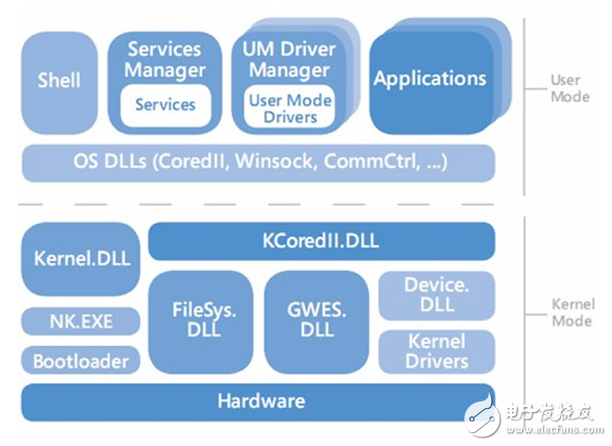
The main features are as follows:
32-bit multitasking embedded operating system.
Multi-tasking preemption, hard real-time.
Supported processor architectures: ARM, x86, SH4, MIPS, etc.
Component development.
Based on Win32 API Set, an extended subset of the desktop system, with over 2000 functions available.
Internet protocol convergence.
Because WinCE provides multimedia function modules and performs well in real-time performance, and at the time Windows application development is convenient, there are many commercial products and services, and a large number of development kits (Kits) and debugging tools (Debug Tools) are provided. At that time, when other operating systems were not mature enough, it was a unique show in car navigation and entertainment. So at that time, it was basically said that the car host was a car navigation or car entertainment system.
However, as demand increases, user needs change, and other operating systems mature. WinCE's highly modular development process has made fewer and fewer development users and more and more applications, so WinCE has gradually withdrawn from the VOS stage.
2. Linux:For computer developers, the birth of Linux can be said to be popular. Because it is freely available under the GNU public license, it is a POSIX compliant operating system. The most important thing is that it is a free-to-use and freely distributed Unix-like operating system.
Known for its efficiency and flexibility, Linux is a multi-user, multi-tasking, multi-threaded and multi-CPU based operating system based on POSIX and UNIX. It runs major UNIX utilities, applications and network protocols and supports both 32-bit and 64-bit hardware. It also includes an X-Windows graphical user interface with multiple window managers that allow windows, icons, and menus to be used to operate the system just as you would with Windows.
At the same time, Linux inherits the design idea of ​​Unix with network as the core. It is a stable multi-user network operating system. The architecture of Linux is as follows:
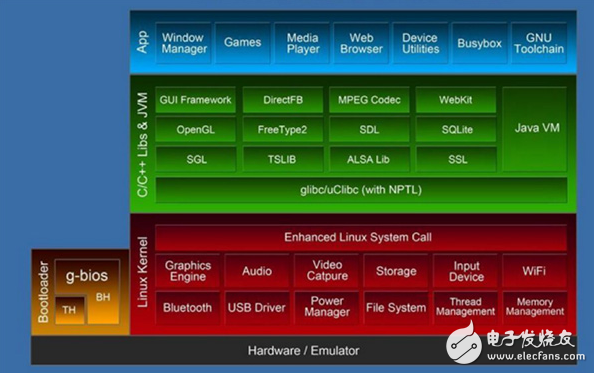
What is easy to misunderstand is that Linux, which everyone says in Xiaobian or on the Internet, actually refers to the Linux kernel. Because the Linux operating system is different because of the publisher, there are different distributions, such as Ubuntu, Debian, Fedroa, RedHat, etc. Each issuer releases its own new version based on the different Linux Kernel versions.
On VOS, most OEM OEMs are based on the Linux Kernel LTS (Long-Term Supported Version) version, and then complete the development of the vehicle operating system by cutting and configuring. Because of the general LTS release, it will provide 2 years of support. Therefore, the stability is better and the maturity is higher.
The Linux operating system architecture design is biased towards reliability and network design, so it is a leader in the back-end (server and data center) operating systems. The IT infrastructure is now moving from servers and data centers to the cloud, while the cloud is running on Linux. Even on Microsoft Azure, more than a third of virtual machines were running on Linux in 2016.
However, the popularity of Linux is small and the development is difficult, which limits its development in car navigation and car entertainment. However, with the intervention of the Internet of Vehicles and ADAS, the demand for reliability and network design, perhaps Linux will suddenly emerge and become a popular system of VOS.
3. AndroidAndroid operating system, let Xiaobian take a straightforward description of everyone. Because the market share of Android phones has exceeded 80%, far higher than the share of any operating system in history. Basically, 8 out of 10 smartphones are Android phones, and most of them may not be familiar with it.
What you may not know is that, by far, Android is the most successful product based on Linux Kernel development (some people think iOS is the most successful product). In 2009, Google and some open hardware alliances of hardware vendors released Android. It has now become the most popular end-user operating system.
Take a look at its architecture and you can see its relationship with Linux:
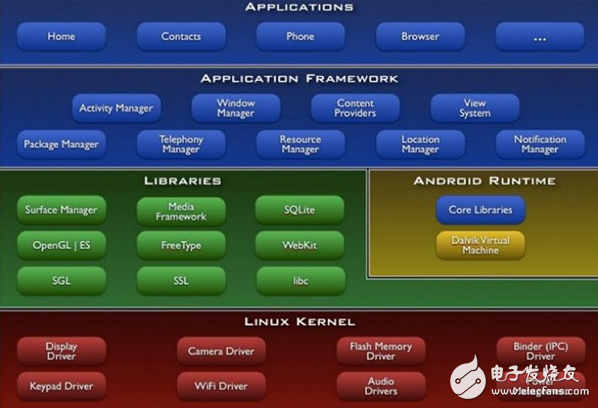
Linux Kernel: The underlying is based on the Linux Kernel. The main accomplishment is the function of the operating system. Basically, there are many drivers that drive the hardware devices on the device and manage the power.
Android RunTIme: Android runtime environment. The Core Libraries in Android Runtime are equivalent to the JDK of Java. It is the core library needed to run the android application. The Dalvik Virtual Machine is equivalent to the JVM. At this time, Google is specially developed for Android to run the virtual machine required for the android application.
Liberaries: Android library files. Including file system, multimedia architecture, SQLite database, graphics processing, library files for web development, and so on.
Application Framework: The framework of the application, this is very important. Through the various frameworks defined by the Framework layer, developers can implement a variety of Applications on the current mobile phone through Java.
Many OEM OEMs choose Android 4.4 as the basis for VOS development. Mainly the 4.4 version has been greatly optimized for RAM, and can even run smoothly on a 512MB RAM car. This is very close to Linux, WinCE. The car configuration with the main purpose of car navigation and car entertainment is also low.
Some big updates in version 4.4 can be Baidu at any time, and Xiaobian will not list them one by one.
The biggest advantage of Android is the huge mobile phone group, which has developed countless applications for its OS, and most of the applications have been deeply rooted in people's hearts. Moreover, with the development of the Internet of Vehicles, it should be possible to transplant to the car machine soon, creating a new era of Internet for car entertainment systems.
However, the Android operating system does not occupy the dominant position on the mobile phone. The rapid development of the smooth development of the car machine is mainly due to the real-time and stability of the system, and of course the excessive demand for resources. This may hinder Android from becoming the biggest obstacle to future VOS. Therefore, Google plans to develop a complete operating system for the car in the development of Android N, so that everyone will wait and see.
4. QNX:You may not know much about QNX. Let's talk about it in detail here.
Blackberry's wholly-owned subsidiary, as the most important component of BlackBerry's core technology division BTS (Blackberry Technology Solutions), undertakes core business content such as operating system, automotive software, M2M, IoT IOT and cloud computing in the BlackBerry business.
– Founded in 1980, the world's first real-time operating system company.
– Provide operating systems, middleware and software solutions for the automotive, communications, networking, medical, defense, aerospace, nuclear power, industrial automation and other market segments .
– Docking from Cisco's routers, Locksted Martin's weapons, GE's transportation equipment, Philips Medical, Alstom's rail transit, Honeywell Omron's industrial equipment, Westinghouse's nuclear reactor controller, to the International Space Station Arm control system, QNX software involves every aspect of people's lives.
QNX is known for its security and real-time performance, so its breakthrough is the car's cluster. The QNX operating system is the first real-time operating system that complies with the ISO26262 ASIL D specification. It meets the functional security requirements of digital instrument clusters while taking into account data security requirements through the US military EAL4+. Users can develop the system based on a secure kernel to ensure the safety and reliability of the whole system.
The architecture of QNX is as follows:
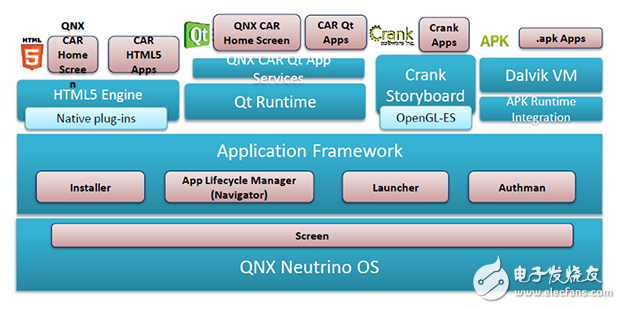
Among all the operating systems described in Xiaobian, only QNX has developed a complete entertainment platform (not a car supplier) for automotive in-vehicle systems based on its own VOS, called QNX CAR Platform for QNX CAR Platform for Infotainment). Its structure is as follows:
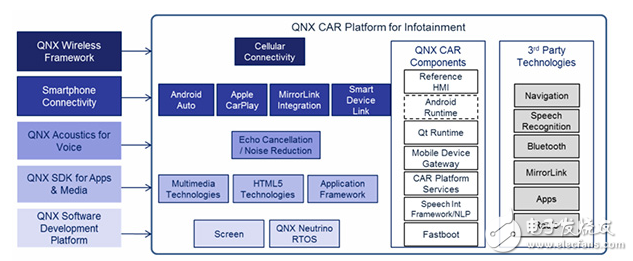
Xiao Bian believes that QNX's ambition is still very big. After all, semi-automatic and fully automatic driving of cars involves people's life safety, safety and real-time. Therefore, Xiaobian believes that QNX has a very big chance of becoming a future VOS.
5. iOS:iOS is a mobile operating system developed by Apple. Apple first announced the system at the Macworld conference on January 9, 2007. It was originally designed for use on the iPhone, and later expanded to include iPod touch, iPad, and Apple TV.
iOS, like Apple's Mac OS X operating system, is a Unix-like commercial operating system. The system was originally called iPhone OS, because iPad, iPhone, iPod touch, Apple TV, iWatch are used, so it was renamed iOS. In other words, all future Apple products are supported by iOS. Today, Apple has entered the field of autonomous vehicles, and Xiaobian is also looking forward to the arrival of iOS as a VOS.
The system architecture of iOS is divided into four levels: core OS layer, core service layer, media layer and Cocoa Touch layer.
The following is the IOS system structure diagram:

Because Apple's development of the car is still in a confidential stage, we can only look forward to the future results. I also hope that, like the iPhone, it will be a blockbuster.
Now let Xiaobian briefly summarize the current status and future of several operating systems with VOS potential:
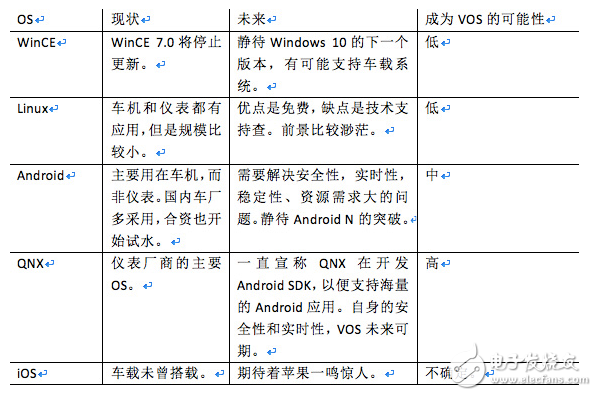
12W Medical Power Supply,Breathing Machine,Respirator Power Supply,Anesthesia Machine Power Supply
Shenzhen Longxc Power Supply Co., Ltd , https://www.longxcpower.com